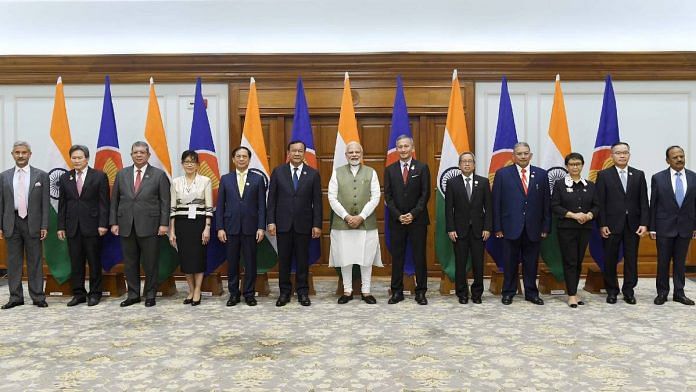New Delhi: As New Delhi prepares to host the G20 Summit this weekend, Prime Minister Narendra Modi is heading to Jakarta, Indonesia, to attend two other international conferences — the 20th ASEAN-India Summit and the 18th East Asia Summit.
The Ministry of External Affairs (MEA) announced Saturday that the PM would travel to Jakarta on 6-7 September at the invitation of Indonesian President Joko Widodo to attend the two summits.
At the ASEAN-India Summit held in Phnom Penh, Cambodia, last year, India and ASEAN announced the elevation of the existing strategic partnership to “comprehensive strategic partnership”.
The Association of Southeast Asian Nations (ASEAN) is an inter-governmental organisation founded on 8 August 1967. It consists of 10 member states — Brunei Darussalam, Cambodia, Indonesia, Myanmar, Lao People’s Democratic Republic (Lao PDR), Malaysia, Philippines, Singapore, Thailand and Vietnam.
As the MEA release noted, the 20th ASEAN-India Summit will review the progress of the India-ASEAN relationship and chart the future course of cooperation.
The East Asia Summit will involve the 10 members of ASEAN and eight dialogue partners — India, China, Japan, Australia, New Zealand, Russia, the Republic of Korea (ROK or South Korea), and the US.
The summit is a forum at which all key Indo-Pacific partners meet to discuss political, security and economic challenges facing the region.
ThePrint explains the significance of the two summits as well as the India-ASEAN relationship.
The India-ASEAN relationship
The India-ASEAN relationship began as a sectoral dialogue in 1992. Three years later, in December 1995, the relationship was elevated to a full dialogue partnership, according to a document put up on the ASEAN website.
The relationship was further strengthened with the convening of the first ASEAN-India summit in 2002 in Phnom Penh. Since then, the summit has been held annually.
In 2009, India and ASEAN signed the ASEAN-India Trade in Goods Agreement (AITIGA), which saw the liberalisation of tariffs on almost 90 percent of products traded between the economic partners.
Then, in 2014, Modi announced the ‘Act East Policy’ focusing on India’s “extended neighbourhood” in the Asia-Pacific region.
“At the 13th ASEAN-India Summit held in Kuala Lumpur on 21 November 2015, the ASEAN leaders welcomed India’s initiative, namely the ‘Act East Policy’, and noted that the initiatives could complement ASEAN community-building efforts,” the ASEAN document noted.
It added that “since India became a dialogue partner of ASEAN, the collaboration has intensified to cover political and security dimensions”.
It also stated that “over the years, ASEAN-India socio-cultural cooperation has expanded to include human resource development, people-to-people contacts, cultural exchanges, education, health, biodiversity, climate change and disaster management”.
On economic cooperation between India and ASEAN, the document noted that India has been a key trade partner for the region.
“According to preliminary data, in 2022, India was the sixth-largest ASEAN trade partner among the ASEAN dialogue partners with total trade amounting to US$ 113.07 billion, which makes 2.94 percent of total ASEAN trade,” it states.
However, a vast deficit of trade has arisen between the ASEAN countries and India. India’s trade deficit with the bloc stood at $43.57 billion in FY23.
Discussions about New Delhi’s asymmetrical trade with the 10-nation bloc are likely to be on the cards at the India-ASEAN summit.
Industry in India is also reported to have raised concerns that China may be diverting its supplies into India via the ASEAN countries.
Meanwhile, the India-ASEAN joint declaration of 2022 looked at the “early completion and operationalisation of the India-Myanmar-Thailand (IMT) Trilateral Highway” and its possible expansion to Lao PDR, Cambodia and Vietnam.
However, the completion of the IMT Highway has faced delays and challenges due to the turmoil in Myanmar, a member state of ASEAN.
Since the coup in Myanmar in 2021, the nation’s military rulers have been barred from attending ASEAN meetings.
A report in Jakarta Globe this month, highlighting the many problems plaguing the ASEAN bloc, said Myanmar had indicated its inability to host the 2026 ASEAN Summit.
“Indonesian foreign minister Retno Marsudi acknowledged the ‘many difficult circumstances in the region’ that the bloc was facing and should overcome, including the Myanmar crisis,” the report said.
East Asia Summit
The EAS, a leader-led forum of 18 countries, was first convened in 2005 as a meeting between the heads of state or government of the 10 ASEAN countries and six dialogue partners. The US and Russia officially began participating in the grouping during its 6th summit held in Bali, Indonesia, in 2011, according to a document on the MEA website.
The concept of an East Asia Grouping was first promoted in 1991 by the then Malaysian Prime Minister Mahathir bin Mohammad, and it was originally meant to be established as an ASEAN plus 3 (China, Japan and ROK) grouping.
Australia, India and New Zealand were welcomed in the EAS at the ASEAN Ministerial Meeting held in Vientiane, Laos, in 2005.
The six priority areas of the EAS are environment and energy, education, finance, global health issues and pandemic diseases, natural disaster management, and ASEAN connectivity, the group’s website states.
(Edited by Nida Fatima Siddiqui)
Also Read: Manufacturing moving to India from China, but trade deficit a concern, says Mark Mobius



